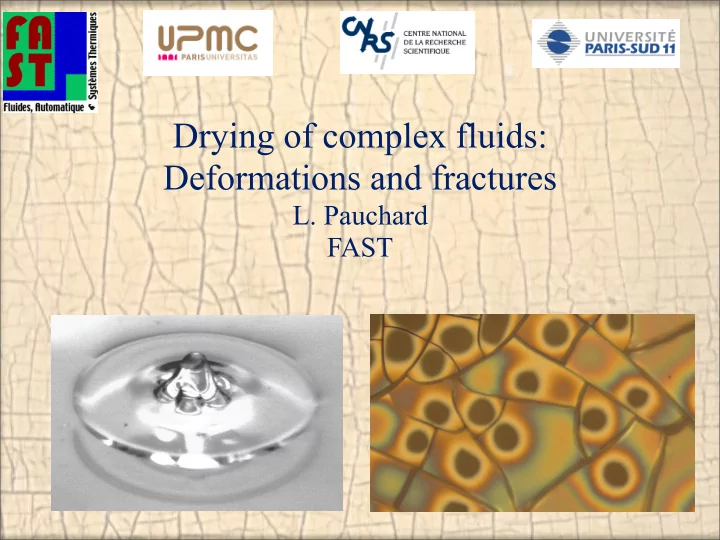

Drying of complex fluids: Deformations and fractures L. Pauchard FAST
Singularities inversion of curvature in shells crack patterns JC Géminard 10 − 1 m A. Davaille directional cracks propagation sea-urchin embryo Carlson (1967) coating 1 m 1mm 100µm A. Davaille
I Drying of drops of complex fluids
I. deformation Drying a sessile drop of complex liquids dilute solutions 3-phase line side view deposition patterns left by a drop of a dilute colloidal suspension top view Deegan, thesis (1998) evaporation-induced flow → deposition of layers (Berteloot et al., Eur. Phys. Lett. (2008))
I. deformation Drying a sessile drop of complex liquids concentrated solutions complex drop shapes due to different process - pinning of the three-phase line - large concentration gradients colloidal suspensions polymer solutions - hydrodynamic (Rayleigh-Bénard or or mechanical instabilities Rayleigh-Bénard or Bénard-Marangoni effects
I. deformation Drying a sessile drop of complex liquids concentrated solutions importance of : - drying conditions, - geometry, - physico-chemical properties of the system.
I. deformation Drying a drop of polymer solution: polymer drop glass transition during desiccation polymer = dextran (hydrosoluble polysaccharide) concentration in mass : from 20 to 40% ( ) ω p 100 semi-dilute regime viscosity (mPa.s) Viscosity (mPa.s) 10 1 0.1 0,001 0,01 0,1 1 ω p (g/g) Tg~220°C (glass transition temperature) solvent loss ⇒ polymer concentration increases ⇒ medium becomes glassy
ω p ,RH,T : constants I. deformation polymer drop H 0 Θ 0 0 Θ =20° 2mm 0 time ? Θ =40° 0 1.2 Θ =40° 0 Θ =20° 1 0 0.8 H/H 0 0.6 0.4 0.2 0 0 0.2 0.4 0.6 0.8 1 1.2 1.4 t/t D complete duration: 2min
ω p ,RH,T : constants I. deformation polymer drop H 0 Θ 0 0 Θ =20° 2mm 0 time ? Θ =40° 0 1.2 Θ =40° 0 Θ =20° 1 0 0.8 H/H 0 0.6 0.4 0.2 0 0 0.2 0.4 0.6 0.8 1 1.2 1.4 t/t D complete duration: 2min
H/H 0 I. deformation 0 0 H/H 0 polymer drop 600s 600s 1 900s 900s 1200s 1200s 0,5 0 R/R 0 R/R 0 -1 -0,5 0 0,5 1 0 0.8 volume (mm 3 ) (b) 0.6 0.4 0.2 t B t B 0 0 200 400 600 800 1000 1200 formation of a glassy skin at the Time (s) evaporation surface 5.0 surface area (mm 2 ) (c) 4.6 deformation: buckling process 4.2 3.8 3.4 t B t B 3.0 0 200 400 600 800 1000 1200 Time (s) t(s)
I. deformation Drop shape characterization polymer drop n ws (1 − RH ) ˙ Evaporation rate: V E = A ( θ 0 ) D a R 0 ⇒ t D = R 0 . V 0 Transfer of solvent in air limited by diffusion ˙ R 0 S 0 V E ˙ Solvent flux conservation at interface V E = D m . ∇ φ p Deformation criterion φ p | surface = φ g (glassy state) ⇒ t B = f ( θ 0 , RH ) R 2 0 90 D m 80 t B >t D : no buckling 70 t B <t D : buckling 60 50 θ (°) θ 0 ( ◦ ) 0 40 30 20 10 0 Pauchard, Allain Europhys. Lett. (2003) 0 0,2 0,4 0 0,6 0,8 1 1 − RH 1-RH Pauchard, Allain Phys. Rev. E (2003)
I. deformation Different patterns polymer drop Axisymmetry Asymmetry Gorand et al. Langmuir (2004)
Inversion of curvature in-plane deformation out-of-plane deformation ρ α fold h 2 � 24(1 − ν 2 ) H 2 + 1 / 8( ∆ − 1 K ) 2 ] ds elastic energy U = Eh [ Föppl (1907)
I. deformation Different patterns polymer drop Axisymmetry Asymmetry Gorand et al. Langmuir (2004)
I. deformation Drying a drop of colloidal suspension colloids drop 2 coupled effects in the sol-gel transformation (case of a silica dispersion) Drying kinetics Gelation kinetics 10 nm evaporation of solvent influence of the ionic strength I: screening charges borne by particles solvent suspension viscosity increases as aggregates form ⇒ colloidal gel = solid porous matrix saturated by solvent t G t D = R 0 . V 0 gelation time drying time t G ˙ R 0 S 0 V E
I. deformation 10 − 1 < t G /t D < 10 t G /t D < 10 − 2 t G /t D > 10 2 colloids drop drying drying + gelation gelation skin formation buckling process Pauchard, Parisse, Allain Phys. Rev. E (1999)
I. deformation Invagination during the collapse of colloids drop an inhomogeneous spheroidal shell super-hydrophobic substrate 2mm invagination in sea-urchin embryo suspension gel air saturation in vapor Morrill (1985) Pauchard, Couder Europhys. Lett. (2004) Goriely, Ben Amar Phys. Rev. Lett. (2005)
I. deformation Crack patterns induced by desiccation colloids drop
Conclusion exemples of problems coupling physico-chemical properties and mechanical properties large domain of elasticity brittle domain stress relaxation ⇒ modifications internal structures ⇒ deformations (wrinkles, fractures) successsive generations of cracks induced by residual stresses
B. Abou C. Allain JC Bacri G. Gauthier F. Elias V. Lazarus K. Sekimoto L. Pauchard F. Parisse G. Aitken C. Lahanier M. Adda-Bedia Y. Couder
Recommend
More recommend